
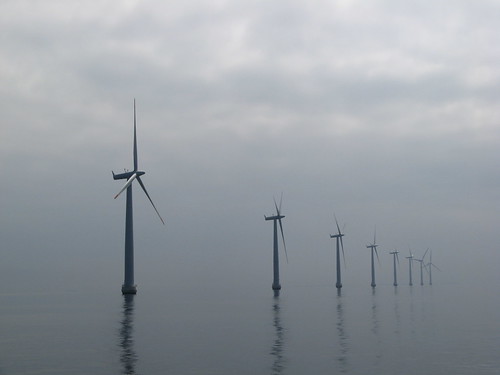
Wind Park in the Haze, originally uploaded by m.prinke.
Thanks to Jack, we got wind of an great article in The New Yorker about a little Danish island called Samsø with huge environmental ambitions.
We knew about the island, of course - in Denmark, Samsø is where the best potatoes come from - and we knew about their eco-goals. But here's an article that explains it in great detail. It's a lovely island [and that's saying something when you have 450 or so of them] and the 4300 islanders decided a decade or so ago to become the world's first carbon-neutral island.
As one expects from the New Yorker, it's a cracking, detailed article. A wonderful read. Read THE ISLAND IN THE WIND - by Elizabeth Kolbert in The New Yorker
Thanks to Corey for letting us know about a CBC radio programme called Quirks and Quarks that featured a bit on Samsø. You can hear the broadcast at the website.
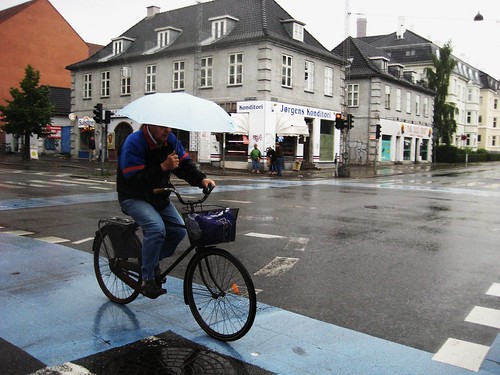
Nothing to do with Samsø... just a cool photo of a Copenhagener in the summer rain.
The Danes are looking at a Dutch study to see if external air bags on cars will help save lives. Since bicycle helmets are so limited in their protection and little conclusive scientific evidence exists that they save lives or prevent serious injury in collisions with other vehicles, it is possible that placement of air bags on cars can help.
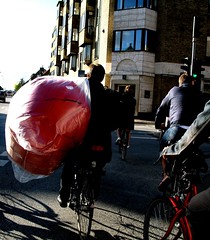
Cyclists are currently using other systems for protection.
Air bags are standard features on all new cars sold in Denmark but it is only the driver and passengers inside the car who benefit from them.
The Danish Cyclists' Union [DCF] wants to change all that. The DCF wants the Traffic Safety Board to research the possibility of putting air bags on the outside of cars, between the hood and the windshield. Last year 62 pedestrians were killed in traffic and between 40-50 cyclists lose their lives on Danish roads each year.
"We should exploit all the technological possibilities that can reduce the number of cyclists and pedestrians who are killed or injured because of impact with cars", said a spokesman for the DCF.
Drawing from the Dutch study.
216 Dutch cyclists were killed in traffic in 2006 and a state sponsored study showed that the lives of 60 cyclists and pedestrians could be saved each year, including prevention of 1500 serious injuries, if air bags are installed between the hood of the car and the windshield.
Airbags on Bikes and Scooters
The chairman of the Traffic Safety Board [Færdselssikkerhedskommissionen] and member of the Parliament's traffic group, Karsten Nonbo, is ready to look at the Dutch study.
"The number of cyclists and pedestrians who lose their lives in traffic is too high. Because of that single fact is is most relevant to look at the results from the Netherlands and at what initiatives and investment can be made to bring the number down", he said.
Karsten Nonbo also mentions that it is worth looking at possibilities for constructing airbags for mounting on bicycles and scooters.
[He does a lot of promising to 'look at things'... would be nicer if he actually had his finger on the pulse as chairman of the Traffic Safety Board and had read the Dutch study when it came out.]
Karsten Nonbo yesterday.
via: DR
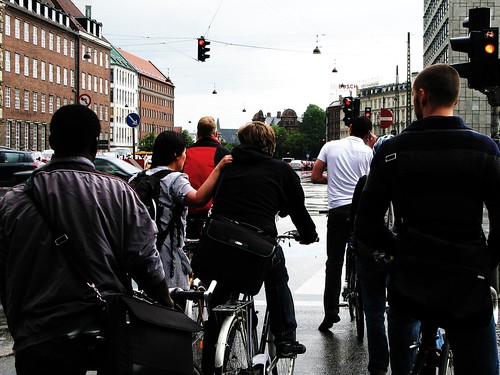
Copenhagners support each other in relationships, just like everywhere else. We just get to do it on bikes sometimes.
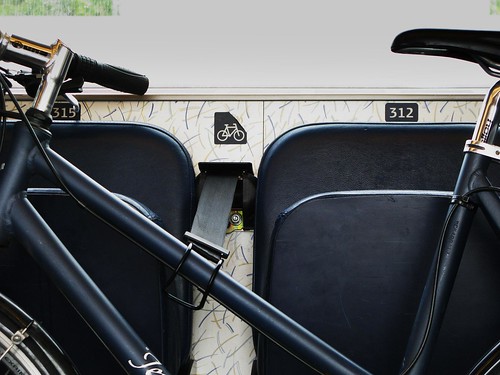
On Danish regional and intercity trains there are compartments for bikes, prams and wheelchairs. You can sit down if you like, but if one of the three vehicles come on board, you move to accomodate them. And, in order to help your bike stay upright, we have these lovely little seatbelty things to assist you and your bike.
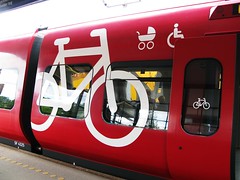
Oh, and in case you're in doubt, this is one of the bike compartments on the local trains.
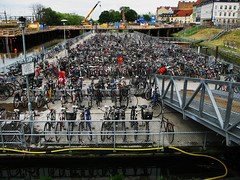
The Central Station in Malmö, Sweden [35 minutes by train from Copenhagen] is undergoing renovations, including building a bike parking garage. Until then, this Bicycle Island floats in the canal next door to the station to accomodate the thousands of bikes.

Another customised cargo bike on the streets of Copenhagen. This one sells fresh fruit cups by the harbour. Fruitbikes.dk.
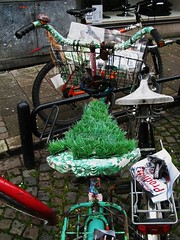
What a splendid ride. Complete with plastic grass.
Our mate Alo in Estonia sent this photo in - thanks_! It it a converted milk carrier from just after the Second World War. Used by the farmer to transport his milk to the collecting point, during the frightfully hard times in the Soviet era. As Alo puts it, the bike helped one family survive the hard years.
In a modern perspective... am I the only one thinking 'beer keg'?
Not to be outdone in the global race to build artifical islands, The City of Copenhagen has revealed plans to build an island in the shape of a national icon - the bicycle - off the coast of the island of Amager, south of Copenhagen.
The Bicycle Island - Cykeløen - as seen from space.
In an unveiling ceremony at the City Hall yesterday, Copenhagen and a consortium of environmental investors and architects from Denmark and Sweden launched the most comprehensive environmental project in Scandinavian history.
'Cykeløen', or The Bicycle Island, will create much needed real estate for an expanding population in the Danish capital and will become the first Danish landmark to be visible from space. The so-called COMA region, consisting of Copenhagen, Denmark and Malmö, Sweden is experiencing massive growth and The Bicycle Island will act as a symbol for the wealthy region. It's proximity to the Öresund Fixed Link bridge and tunnel that connects Copenhagen to Southern Sweden is important for the whole region.

The Øresund Fixed Link Bridge/Tunnel. © Mikael Colville-Andersen
While there are plans for both luxury and afforable housing with spectacular sea views for 50,000 citizens, the majority of the island will be earmarked for recreational usage and organic farming, as well as an Environmental Research Institute, which will explore and develop future intiatives.
The bicycle has long been a symbol of Danishness and now it is being used as a symbol of the sustainable, environmental goals of the city of Copenhagen, which plans on being the World's Environmental Capital by 2015. Over 36% of the population of Copenhagen ride their bicycles each day on a network of dedicated bicycle lanes and paths.
In accordance with the environmental goals set by the city, The Bicycle Island will be fully self-sustainable. All power will be generated by offshore wind turbines and all waste will be recycled. The goal is becoming the world's first carbon-neutral island.
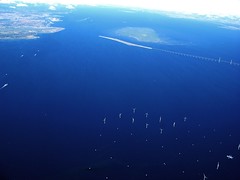
The construction of a massive wind farm just to the east of the proposed island has already begun. The power generated will provide the power necessary to build the Bicycle Island. Plans include electric construction vechicles. © Mikael Colville-Andersen
With spectacular artificial islands under construction in Dubai in the shape of palm trees and a world map, and with the recent announcement that the Netherlands is planning construction of an artificial island shaped like that nation's symbol, the tulip, Copenhagen decided to push forward the plans.

Wind Turbines in Copenhagen Harbour. © Mikael Colville-Andersen
"The choice of a bicycle is obvious for Copenhagen. And the granny bike is a traditional design form in Danish history - it is still the most used kind of bike in the city - and in using this bike design as the shape of the island, we are combining past, present and future in one fell swoop", the press release states.
The proposed Dutch tulip island.
More detailed plans are expected to be unveiled at the COP15 - Global Climate Conference to be held in Copenhagen next year.
So often it's the simplest of ideas that are the most brilliant. Here's the very basic equation:
Baisikeli means 'bicycle' in Swahili and it is a dynamic, visionary Danish initiative started by Niels Bonefeld and Henrik Smedegaard Mortensen.
Henrik Smedegaard Mortensen & Niels Bonefeld from Baisikeli outside their rental shop.
Their philosophy is brilliant:
"Our philosophical starting point is social innovation: to make a difference for people and to give them the possibility of developing themselves professionally and socially. It is based on the belief that the best foreign aid is based on regular commercial market. A purely subsidized development project will make the African partners completely dependent of donations from other countries."
How it works
In Denmark when a bike gets stolen or lost, you get compensation from your insurance company. If the bike is later retrieved, the insurance company then owns the bike. Denmark has a serial number system for bikes so that every bike has a number engraved on the frame. The retrieved bikes are often scrapped. Baisikeli has an arrangement with several Danish insurance companies and they are given heaps of bikes.
There are other bike charity programmes out there. Through UNICEF you can buy a bike for the third-world as a Christmas present . There are big bike corporations that have a 'bike relief' programme as icing on their profit cake. Baisikeli, however, isn't about driving a truck into a village and dumping out a pile of bikes for the locals. It's about creating a dynamic circle
Baisikeli has set up three projects in Ghana, Sierra Leone and Tanzania. The bikes are shipped to their bicycle workshops in these countries, where they are repaired by local mechanics and sold to local distributors, who in turn sell them to the local population.
Workshop in Africa fixing up Danish bikes and converting them to work bikes.
The project is geared to reverse the flow of bicycles back to the first-world from the African workshops. They are developing a Baisikeli bike that will be built in Africa and returned to Europe, where the bike rental shop, from next year, will rent out these Fair Trade bikes to tourists.
Financing the project
Simple ideas are fantastic, but making them happen quite another. Henrik and Niels have that all figured out. They take the best bikes out of the batch and rent them to tourists in Copenhagen in the peak summer months and lease them to foreign students and companies year-round. In addition, they provide bikes for participants at green conferences around the country.
A Baisikeli customer returns his bike and tells Henrik about his bike lane journey.
They work in tandem with the Københavns Genbrug Compagni - Copenhagen Recycling Company [KGC] - a workshop that takes in unemployed citizens and trains them to fix bikes, giving them a trade and a chance to get a job afterwards. The KGC fixes up the bikes for the rental shop.
The money Baisikeli makes off of renting and leasing is used to ship containers filled with Danish bikes to Africa. One third of the profit goes directly to the development project and two-thirds is invested in developing the workshops.
From next year, the Baisikeli bikes being produced in Africa will instead be used to rent out to tourists, completing the loop.
Work Bikes for Africa
In addition to the Danish bikes now rolling across the African landscape, Baisikeli helps the workshops convert bikes in much-needed work bikes for carrying cargo like water or food or firewood. As well as bikes with a stretcher to act as an ambulance.

A bike converted into a water carrying workbike in Tanzania.
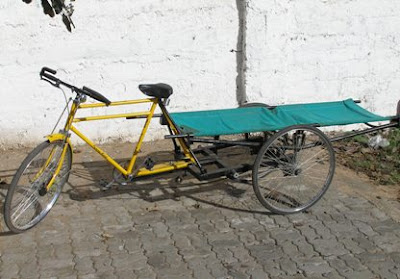
An ambulance bike in Tanzania.
In addition, in the Ghana part of the project, Baisikeli provides bikes for children in outlying areas in order for them to get to school. In Sierra Leone, a workshop is located on the premises of a hospital, providing bikes for the locals and converting the bikes into various work bikes.
If you ever come to Copenhagen, you'll need a bike to get around. And we recommend you head straight for Baisikeli. You can choose between many different styles and find the one that suits you best. You can ride around the city and know that you're directly helping African communities in the process. Can't beat that.
And if you're a Copenhagener with a bike you don't need, ride it down to the shop and donate it!
- Baisikeli - Copenhagen Bike Rental - with maps of their location and much more about their project.
- Cool Youtube film about the project.
- Smarty Hardy - workshop in Tanzania.
- Baisikeli.dk - Danish site about the project.

I love this. There is no need for a little ramp here. It requires no great effort to get your bike from backyard bike racks to the street.
Nevertheless, some Copenhagener deemed it necessary and cosy to make one. They used time and effort for this little bit of niceness.
Every little bit helps.
UPDATE
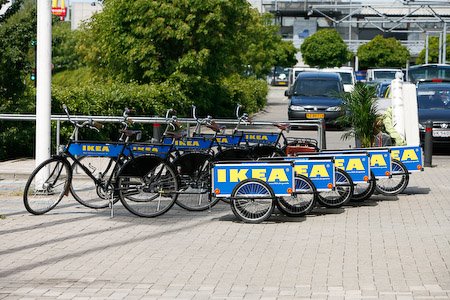
Regarding our previous post about IKEA's collaboration with Velorbis in loaning out bikes and trailers from their big box stores , here's a little update.
The first IKEA in Copenhagen to loan out the bikes is in Gentofte, north of the city. Since the programme started, IKEA reps from Sweden, Germany and China have flown in to visit the Gentofte store and to see the Velorbis bikes and trailers in action.
The response has been overwhelmingly positive, so here's hoping the idea spreads quicker than a Dane can dismount a bicycle.
Read more at the website for the programme FREETRAILER.DK
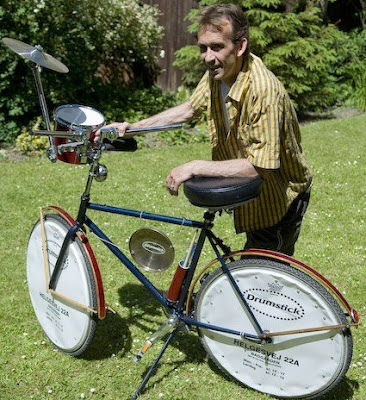
Søren Juel with his Drum Bike - Photo from his website drumstick.dk
It can be tricky combining one's passion for different things in life but a chap named Søren Juel in Copenhagen seems to have managed it. Drums are his life as owner of the very cool drum shop and workshopDrumstick. He is also a Copenhagener which means, of course, he gets around by bike.
Enter the Drum Bike [Trommecyklen].
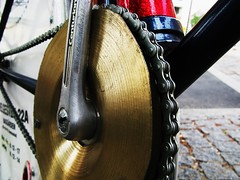
The idea started when a drum playing bikesmith who frequents the shop suggested a hybrid between drums and bikes. It took time to work out how different drum kit gear could be set onto a bike, but they succeeded in the end.
Wherever possible drum gear is used, like the cymbal on the chain above.

The fenders are made from 26 inch vintage Premier Bass hoops, with original Gretsch Red sparkle coating. They're held in place by drumsticks.

On the wheels are drumskins with an advert for his shop. Drumsticks can be placed in the holder on the frame and a cymbal hangs from the crossbar.
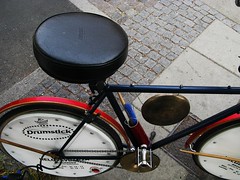
Søren admits that the drum stool isn't the most comfortable to ride around on for longer journeys - for those he uses his old 'granny' bike to get around. But during the Copenhagen Jazz Festival he only uses his Drum Bicycle.
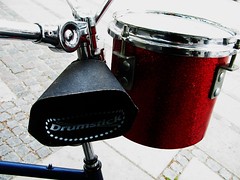
Bells are required by law in Copenhagen, and the Drum Bicycle is no exception. Just grab a drumstick out of the holder and give this cow bell a whack to let them know you're coming.

The handlebars are made out of drum kit and there is a cymbal and a drum mounted on the front for spontaneous cyclobeats.
Customising one's bike is popular in Copenhagen and Søren Juel leads the band with his Drum Bicycle.
Drumstick is located on Helgesvej 22A in Frederiksberg.
The bike is usually parked down on the corner of Helgesvej and Falkonér Allé during opening hours, used as an advert for the shop.
The Copenhagen Jazz Festival is the second larget jazz festival in the world and takes place each July.
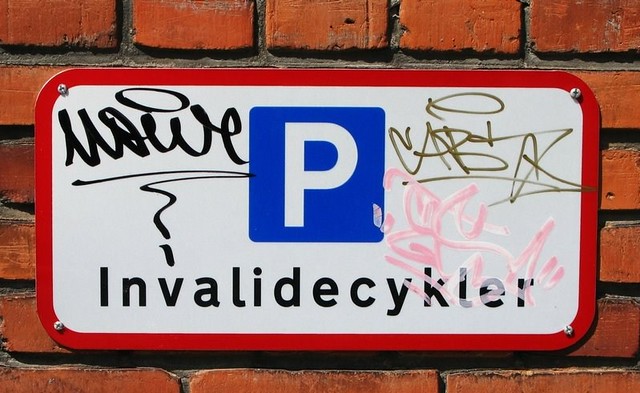
We have bike racks, sure, but we also have reserved parking for Invalidecykler - disabled or elderly cyclists with special bikes.
I met up with a team from Trek Bikes from the States yesterday. Three designers and product executive. From left: Joe [from the Dutch office], Erika [designer], Dan [The Man - the product executive] and Heidi [designer].
Heidi contacted me a while back and asked if we could hook up for a chat about Danish bike culture and bike-related design. They are on a research trip around Europe; Münster, Zürich, Amsterdam and Copenhagen.
What a lovely group of people. We hung out for a couple of hours before they headed off to do some shopping on their last day. They had been riding all around Copenhagen visiting bike shops that sell their Trek Bikes and gear.
I usually meet up with visitors who wish to talk to me about bicyle culture and infrastructure in Copenhagen so it was cool to hang with some creatives with a different angle. It's always great when design can inspire design, across borders and oceans.
These appeared the other day at various intersections around Copenhagen. On the bike lanes to remind cyclists to "Watch out for blind spots". Right hook accidents are high profile stuff in the media, which kind of blows it out of proportion, but simple signs like this are always good.
The Traffic Safety Board had a campaign in the same vein on the City Hall Square yesterday, with the same theme.
I love these signs. 'Ensrettet' means 'One Way' and then underneath 'Cyclists Excepted'.
A quick note about the Dreams on Wheels Exhibition about Danish Bike Culture.
It's currently in Sydney, Australia. You can catch it - and my photos - until the 22 June, before it moves on. More ozzie info here. Here's an article from the Sydney Morning Herald about it.
Quirky news about our Dutch friends. Teaching the Dutch how to steal bikes.
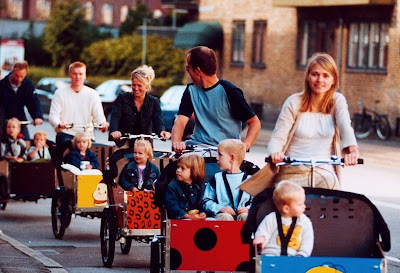
Cargo bikes are a way of life here in the spiritual home of cargo bikes. There are many brands to choose from in Denmark and these bikes/trikes are experiencing a period of rapid growth. More and more people are choosing a cargo bike when they have kids, either as their primary form of transport or instead of a second car. The main players on the market are also popular abroad. We've written previously about the Nihola and other Danish brands . But there is another brand that is slowly but surely gaining in popularity, and with good reason.
Bellabike isn't just another cargo bike brand. When I visited the owner Erik at their showroom in Copenhagen I was bowled over by his passion and enthusiasm. Other larger brands seem to be merely going through the motions - they have a popular brand and they know and they keep on producing them, which is, of course, fine. But Bellabike still has that passion and enthusiasm surrounding it.
What we like about Bellabike most is that it's a husband and wife show and that it all started on a very personal level, without any plans to start a bike brand. It began when Erik's wife fancied a cargo bike. Erik welded a frame together and put on a box himself. There were performance issues with the inaugural bike and the two of them worked in tandem on improving it. Erik's wife was the safety general and Erik followed her suggestions on the construction side of it. They ended up with such a cool bike that soon all of their friends wanted one.

Bellabikes - Danish design with emphasis on practical usage.
Erik whipped together 11 bikes. However, when he presented their friends with the price tag, they didn't expect to have to pay for them, so Erik and his wife were stuck with 11 cargo bikes in need of a home. Fine. They chucked them into a newspaper to sell them, only to discover that they couldn't do so without a serial number on the frame. Serial numbers are issued by the police. Fine. The police, however, informed them that you could only get serial numbers issued if you were a company. Fine. A company was founded in order to offload the 11 cargo bikes.
Bellabike has a large workshop just outside of Copenhagen and a little workshop at the back of their showroom where they can assemble bikes. It takes 5-6 hours to assemble a bike.
Once everything was in order, the cargo bikes disappeared to grateful buyers in a flash. Only then did Erik and his wife realise they were, perhaps, onto something good. A spontaneous, organic process led to a great idea.
Today, eight years on, Bellabike has wheeled its way into the mainstream cargo bike market in Denmark and Scandinavia and is growing steadily and healthily. The export market looms ahead and Bellabike is preparing to expand abroad.

Personalising your bike is a must in Copenhagen and Bellabike has made this one of their trademarks.
Bellabike is in constant development. Buyers often bring their own needs to the table and Bellabike will find a solution. Many of their buyers are kindergartens who need to transport kids to parks, museums, theatres, etc. Companies buy them, including a newspaper 24timer, who have fleet of them to hand out their papers on the streets. Families buy them for getting around town with their kids. Bellabike is constantly thinking 'out of the box' with regards to how to improve their bikes.
Seating for four kids in a Bellabike.
There are many version of seats in the cargo box. Two kids, four kids, one kid and a baby lift. Four kids sitting either across from each other like on a train or in rows like on a bus. Whatever you need, you can get it.
Bellabikes in the showroom.
Bellabike is cool because it is an idealistic company. They have firm values and they stick to them. You don't pay through the teeth for extras like locks. As Erik said to me, it's all about the bike. Why should they try to make money off of every little accessory? There's nothing more irritating than spending a heap of money on a bike and then having to shell out for puncture-proof tyres, locks, better brakes. All the best gear is standard on the Bellabike. It is also very competitively priced compared to the other players on the market.
For a basic model you're looking at between 11,000 and 12,000 kroner [divide by 5 for dollars] and with some customized accessories, you can reach about 15,000 kroner. Still a few thousand kroner cheaper than other brands.
The bike has rear wheel steering, which is gaining in popularity. You can turn on a coin and this manoveurability is fantastic in an urban setting. There is hydraulic steering suspension to ensure stable cycling and steering at all times, 3 separate brake systems – disk brake, coaster brake and pivot brake used when parking and the cargo box is made out of aluminium sheets around a safe frame to keep the weight down. Five gears are always helpful on a cargo bike, especially if you have 150 kg in the cargo box.
Two generations of Bellabikes - the classic in the background and the newest version in the foreground.
Bellabike.com's website is currently only available in Danish, but it is image rich so there's lot's to see. They are working on an English version.
- Gallery of customized boxes.
- Photos of how the cargo box can be used.
- Prices
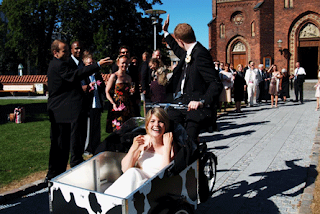
Customers who used their Bellabike at their wedding.
We like the Bellabike. We like their passion, their values and we like their cool bikes. There's always room for more cargo bike brands in Denmark, especially if they are as passionate as the good people at Bellabike.
Our good friend Raquel from the Spanish fashion blog Gratis Total spent the weekend in Ibiza [Eivissa to the locals] and took this photo of a bike rack outside a sushi restaurant.
I figured it was appropriate seeing as how the bike on the left is clearly owned by a member of the Oranje Army and the Netherlands have advanced easily into the quarter finals last night. One world - one sport. One world - two wheels.
Here's a few classic cargo bike shots from the past few days in Copenhagen. Above is a typical cross section of Copenhageners waiting for the light to change, including man in suit on his Nihola .

Streetcleaners on one of the pedestrian streets in the heart of Copenhagen, riding customized Nihola cargo bikes. The chap in the background is picking up some trash with a 'grabber', while seated on his bike seat.
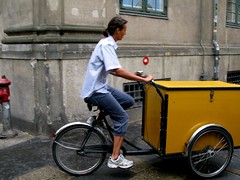
The Royal Danish Post uses customized Christiania Bikes for the post-heavy routes in the city centre.
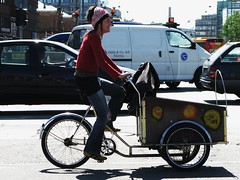
A charmingly personalized Christiania bike on the City Hall Square.
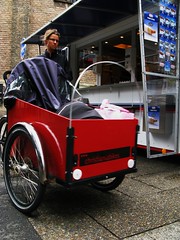
A Christiania bike rolling past a traditional Danish sausage stand - 'pølsevogn' - on Købmagergade in the heart of the city.
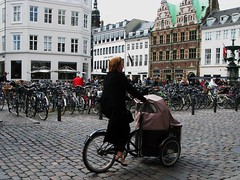
A Nihola in its natural environment. Copenhagen C.
For more posts on Danish cargo bike brands and culture:
- "Cargo Bike" tag.
- Slice of Copenhagen Cargo Bike Life
- Test of Five Cargo Bikes




